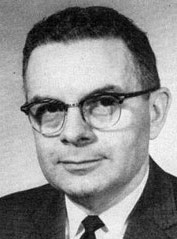-
(b.) -1914(d.)2003 August 05
Bio/Description
Born in Duluth, MN; he was a renowned physicist, noted for his significant contributions as a pioneer in the computer industry, primarily in the design and development of digital magnetic storage. An employee of Engineering Research Associates (ERA) from its inception in 1946, and a founder of AFIPS; his IEEE Fellow citation read: "For pioneering achievement on computers and storage devices, and sustained service to the profession in this field." He earned his Bachelor?s degree in Electrical Engineering in 1935, a Master?s degree in 1938, and a Ph.D. in Physics in 1947, all from the University of Minnesota. He joined RCA in 1942, working in gaseous electron tube development, largely for military use; later for other applications. His first contact with the computer field came when he joined Engineering Research Associates (ERA) in 1946. He was first assigned to information storage problems, under ONR sponsorship, initially analyzing the feasibility of storing information on beams of charged particles. Then, he worked on the development of selectively alterable digital storage on magnetic drums; the patent that resulted turned out to be basic in the field. He then led system design of the ATLAS I magnetic drum computer for the National Security Agency (a later commercial version was called the ERA 1101). ATLAS I, which was delivered in December 1950, is believed to be the first stored-program electronic digital computer actually shipped to a customer site. He was also responsible for the ATLAS II system design (commercialized as the Univac Scientific 1103 after the Remington-Rand merger in 1952). ATLAS II had both CRT and magnetic drum storage. Variations on these systems, including a magnetic core memory at an early date, were built and delivered for specific requirements, mostly military. The commercial 1103A which followed incorporated powerful new system features, in addition to core and drum storage. An important aspect of ERA's business was to conduct digital systems work for outside customers, in response to requests for proposals, or as unsolicited proposals. He had responsibility for much of the design and development in these areas. One early effort (1949-1950) which he led was a design study for IBM that called for a magnetic drum computer with punched-card input and output, for commercial applications. Although this work resulted in a massive system patent that was assigned to IBM, a parallel design program within IBM prevailed, ultimately producing the IBM 650. ERA was acquired in 1952 by Remington-Rand, which had a development group of its own in Connecticut, and which had in addition picked up Eckert-Mauchly Corporation in 1950. This brought together, as the Remington-Rand Univac division, three development and manufacturing locations, and an assortment of marketing groups. He continued to be actively engaged in various phases of technical management, including system planning, government relations, and marketing support. In 1971 he joined the staff of the Dean of the Institute of Technology at the University of Minnesota, as Assistant Dean for industry and professional relations. Upon retirement from the dean's staff in 1979, he became active in helping to form the Charles Babbage Institute for the History of Information Processing, which has since become a part of the University of Minnesota. He has been a Senior Fellow at CBI and was a member of the Charles Babbage Foundation's Board of Directors. He has received numerous honors and awards to include: National Chair, IRE Professional Group-Electronic Computers, 1960-1962, [Now IEEE Computer Society]; member, Board of Directors, AFIPS, 1960-1965; Member, Scientific Advisory Board, National Security Agency, Ft. Meade, Md., 1960-1974; in the 1960's, he was honored by the State of Minnesota as "Inventor of the Year" for his achievements in computer engineering, and was awarded the Valuable Invention Citation, Minnesota and American Patent Law Association, 1962; Fellow, IEEE, 1964; member, Advisory Board, Chemical Abstracts Service, 1969-1972; and IEEE Centennial Award, 1984. He authored or co-authored: Armer, Paul, et al., "Reflections on a Quarter Century: AFIPS Founders," Ann. Hist. Comp ., Vol. 8, No. 3, July 1986, pp. 225-256; and with Tomash, Erwin, "The Birth of an ERA: Engineering Research Associates, Inc., 1946-1955," Ann. Hist. Comp. , Vol. 1, No. 2, 1978, pp. 83-97. In addition, as a member of the ERA Staff, he was a contributing author of ?High Speed Computing Devices?, McGraw-Hill, 1950; reprinted in Charles Babbage Reprint Series, MIT Press, Boston, Mass., 1983, for which he wrote the introductory chapter. He was also active in the Mpls Jewish community, serving as Vice President and long-term board member of the Adath Jeshurun Congregation.
-
Date of Birth:
1914 -
Date of Death:
2003 August 05 -
Gender:
Male -
Noted For:
Developed selectively alterable digital storage on magnetic drums -
Category of Achievement:
-
More Info:


